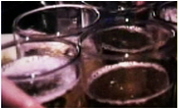In an effort to understand the drinking tendencies and patterns of the working population and thereby provide the basic data needed to solve drinking related issues, this study was conducted by subjecting 1,074 public officials of the P region to a su...
http://chineseinput.net/에서 pinyin(병음)방식으로 중국어를 변환할 수 있습니다.
변환된 중국어를 복사하여 사용하시면 됩니다.
- 中文 을 입력하시려면 zhongwen을 입력하시고 space를누르시면됩니다.
- 北京 을 입력하시려면 beijing을 입력하시고 space를 누르시면 됩니다.
https://www.riss.kr/link?id=T11790360
- 저자
-
발행사항
대구 : 경북대학교 보건대학원, 2009
-
학위논문사항
학위논문(석사) -- 경북대학교 보건대학원 , 역학 및 건강증진학과 , 2009. 8
-
발행연도
2009
-
작성언어
한국어
- 주제어
-
발행국(도시)
대구
-
형태사항
41 p. ; 26cm
- 소장기관
-
0
상세조회 -
0
다운로드
부가정보
다국어 초록 (Multilingual Abstract)
The average drinking rate of the subjects was 97.6%(98.7% among males, 95.2% among females), the yearly drinking rate 96.6%(97.5% among males, 94.3% among females), and the monthly drinking rate 86.2%(93.8% among males, 67.5% among females). Regarding their first drinking experience, 52.5% replied that it was after graduating from high school. The frequency of high risk drinking defined as more than 7 glasses or 5 cans of beer at one seating for men, and 5 glasses or 3 cans of beer or more per seating for women was 65.2%(79.9% among males, 29.7% among females), and the percentage of people conducting high risk drinking more than 3 times a week was also quite high, at a value of 10.5%(14.2% among males, 1.4% among females). Also, the percentage of those who experience so called 'blackouts'-the phenomenon of not being able to remember what happened while drinking after one sobers up-more than once a week was 20.1%(19.4% among males, 0.7% among females). With regards to the perception of drinking amongst the subjects, males had a relatively more positive perception of drinking, and drinkers had a more positive perception of drinking compared to non-drinkers, which is a significant difference.
The percentage of subjects aware of the 'Don't Pass the Glass Movement' promoted by the P city area was 98.2%(98.9% among males, 96.7% among females). This level of awareness was higher amongst those in higher positions and those with longer careers, and 55.2% responded that they were participating in the movement. The number of those who did not participate before but do now was 32.8%, signifying that 'Don't Pass the Glass' movement, so actively promoted by the governor of the P region is being implemented successfully, at least in the public organizations.
The aforementioned results show that the drinking patterns of the public officials of the P region are very forgiving and allowing, and problematic drinking tendencies were recognized. Therefore, there is reason to deal with the problem of drinking as a social issue, and I intend to propose ways to rid our society of negative drinking habits.
First of all, in the case of public and government organizations, the interest and will of the governor of the municipality to promote an atmosphere of drinking in moderation must be drawn out, and active intervention with regards to drinking problems through methods such as providing accurate information on job stress management and drinking through professional agencies such as public health centers and alcohol consultation centers is required. Also, when it comes to future acts of intervention aimed at solving the drinking issues of the working population, efforts should be made to promote drinking related programs and provide a comprehensive basis for individual efforts by cooperating with the management and labor unions to implement a healthy drinking in moderation atmosphere and actively promote drinking related programs.
In an effort to understand the drinking tendencies and patterns of the working population and thereby provide the basic data needed to solve drinking related issues, this study was conducted by subjecting 1,074 public officials of the P region to a survey between February 26th, 2009, and March 4th of the same year.
The average drinking rate of the subjects was 97.6%(98.7% among males, 95.2% among females), the yearly drinking rate 96.6%(97.5% among males, 94.3% among females), and the monthly drinking rate 86.2%(93.8% among males, 67.5% among females). Regarding their first drinking experience, 52.5% replied that it was after graduating from high school. The frequency of high risk drinking defined as more than 7 glasses or 5 cans of beer at one seating for men, and 5 glasses or 3 cans of beer or more per seating for women was 65.2%(79.9% among males, 29.7% among females), and the percentage of people conducting high risk drinking more than 3 times a week was also quite high, at a value of 10.5%(14.2% among males, 1.4% among females). Also, the percentage of those who experience so called 'blackouts'-the phenomenon of not being able to remember what happened while drinking after one sobers up-more than once a week was 20.1%(19.4% among males, 0.7% among females). With regards to the perception of drinking amongst the subjects, males had a relatively more positive perception of drinking, and drinkers had a more positive perception of drinking compared to non-drinkers, which is a significant difference.
The percentage of subjects aware of the 'Don't Pass the Glass Movement' promoted by the P city area was 98.2%(98.9% among males, 96.7% among females). This level of awareness was higher amongst those in higher positions and those with longer careers, and 55.2% responded that they were participating in the movement. The number of those who did not participate before but do now was 32.8%, signifying that 'Don't Pass the Glass' movement, so actively promoted by the governor of the P region is being implemented successfully, at least in the public organizations.
The aforementioned results show that the drinking patterns of the public officials of the P region are very forgiving and allowing, and problematic drinking tendencies were recognized. Therefore, there is reason to deal with the problem of drinking as a social issue, and I intend to propose ways to rid our society of negative drinking habits.
First of all, in the case of public and government organizations, the interest and will of the governor of the municipality to promote an atmosphere of drinking in moderation must be drawn out, and active intervention with regards to drinking problems through methods such as providing accurate information on job stress management and drinking through professional agencies such as public health centers and alcohol consultation centers is required. Also, when it comes to future acts of intervention aimed at solving the drinking issues of the working population, efforts should be made to promote drinking related programs and provide a comprehensive basis for individual efforts by cooperating with the management and labor unions to implement a healthy drinking in moderation atmosphere and actively promote drinking related programs.
목차 (Table of Contents)
- Ⅰ.서론 1
- Ⅱ.대상및 방법 3
- 1.연구대상 3
- 2.연구도구 및 방법 3
- 3.자료분석 4
- Ⅰ.서론 1
- Ⅱ.대상및 방법 3
- 1.연구대상 3
- 2.연구도구 및 방법 3
- 3.자료분석 4
- Ⅲ.성적 5
- 1.대상자의일반적특성 5
- 2.대상자의음주실태 7
- 3.대상자의음주후경험 15
- 4.대상자의음주에대한인식 17
- 5.술잔안돌리기운동에대한인지및 실천여부 21
- Ⅳ.고찰 25
- Ⅴ.요약및결론 29
- 참고문헌 31
- 부록 34
- 영문초록 40









